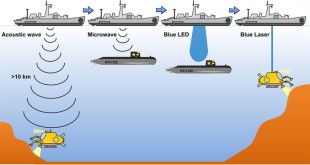In today’s fast-paced technological landscape, there is a growing demand for devices that can process massive amounts of data faster and more efficiently. Traditional electronics, though powerful, face limitations as they reach the upper limits of speed and energy efficiency. Enter Photonic-Electronic Convergence (PEC) devices, a cutting-edge approach that merges the speed and efficiency of light with the versatility and complexity of electronics. By integrating optical (photonic) and electronic components into a unified platform, PEC devices are transforming the way we handle data, paving the way for next-generation applications in communication, computing, and beyond.
What is Photonic-Electronic Convergence?
Photonic-electronic convergence refers to the seamless integration of optical (light-based) and electronic (electric charge-based) components in a single device or system. Photonics, which uses light to transmit and process information, offers distinct advantages over traditional electronics, such as higher bandwidth and lower energy consumption. However, electronics excel in certain processing tasks and can efficiently store and manipulate data.
Photonic devices utilize light to transmit and process information, offering advantages such as high speed, low power consumption, and immunity to electromagnetic interference. On the other hand, electronic devices rely on electrical signals, providing flexibility and programmability. PEC devices aim to bridge the gap between these two technologies, creating hybrid systems that leverage the best of both worlds.
PEC devices aim to combine the best of both worlds. By leveraging the fast data transmission capabilities of photonics with the complex processing capabilities of electronics, PEC devices can overcome the inherent limitations of each individual technology. This convergence is particularly relevant as data centers, telecommunication networks, and advanced computing systems increasingly demand ultra-fast data processing and minimal energy use.
Key Drivers Behind PEC Development
Several factors are propelling the development of PEC devices:
- Data Growth: The exponential growth in global data, driven by applications such as video streaming, cloud computing, artificial intelligence, and the Internet of Things (IoT), has created a need for faster, more efficient data processing and transmission technologies.
- Energy Efficiency: As electronic devices scale down, the energy required to power them becomes a bottleneck. Photonics, which relies on light instead of electricity, offers a more energy-efficient alternative for data transmission.
- Bandwidth Demands: Optical signals can carry much more information over a single channel compared to electrical signals, providing higher bandwidth and faster communication.
- Miniaturization: Advances in nanotechnology have enabled the integration of both photonic and electronic components on the same chip, making it feasible to develop compact, highly efficient PEC devices.
How PEC Devices Work
PEC devices operate by blending photonic and electronic elements into a unified system. Photonic components, such as lasers, waveguides, and modulators, are used for transmitting data as light signals. Electronic components, such as transistors and logic gates, handle data processing, storage, and control functions. These two domains communicate through optoelectronic interfaces, which convert electronic signals to light and vice versa.
This hybrid approach significantly improves performance in areas where traditional electronics fall short:
- Speed: Photonics enables data to be transmitted at nearly the speed of light, significantly reducing latency.
- Bandwidth: Photonics can carry vast amounts of data over a single optical fiber, offering much greater bandwidth than copper cables or traditional electronic interconnects.
- Power Efficiency: Light-based data transmission consumes less power, especially over long distances, helping reduce the overall energy footprint of data centers and networks.
Applications of PEC Devices
PEC devices are poised to impact a wide range of industries and applications, including:
1. Data Centers and Telecommunication Networks
Modern data centers are the backbone of the internet and cloud computing, and they are under immense pressure to handle skyrocketing data volumes. PEC devices can boost the speed and efficiency of data transfer within data centers, enabling faster processing and reducing energy consumption. In telecommunication networks, PEC devices are driving advances in fiber-optic communications, offering higher data throughput for applications like 5G and future 6G networks.
2. High-Performance Computing (HPC)
Supercomputers and quantum computers require ultra-fast data processing and transfer. Photonic-electronic convergence offers a way to achieve unparalleled computational speeds by reducing the time taken to move data between processors, memory units, and storage devices. PEC technology also addresses the heat management challenges faced by traditional HPC systems, where excessive heat generation limits performance.
3. Artificial Intelligence and Machine Learning
AI algorithms rely on vast amounts of data for training and inference tasks. PEC devices can accelerate data processing, allowing for real-time AI decision-making in areas like autonomous vehicles, robotics, and predictive analytics. The convergence of photonics and electronics in AI chips enhances both the speed and energy efficiency of machine learning computations.
4. Medical Devices and Sensing
Medical diagnostic devices and sensors require fast, precise data acquisition and processing. PEC technology enables the development of advanced biosensors that can transmit high-fidelity data using optical signals, making real-time monitoring of patients more effective. Applications in non-invasive diagnostics, medical imaging, and telemedicine will benefit from the higher speed and accuracy of PEC devices.
5. Wearable and Consumer Electronics
The demand for faster, more efficient electronics is not limited to industrial applications. Wearable devices, smartphones, and augmented reality (AR) headsets can all benefit from PEC technology. The combination of photonics and electronics can extend battery life while offering users faster, more responsive devices for everyday use.
NTT Innovative Devices: Pioneering the Future with PEC Technology
NTT Corporation (NTT) has recently launched a groundbreaking venture with the establishment of NTT Innovative Devices Corp. This new entity is dedicated to the development, design, and manufacturing of Photonic-Electronic Convergence (PEC) devices, a crucial component in advancing NTT’s ambitious Innovative Optical and Wireless Network (IOWN) initiative. The IOWN initiative aims to build a global communications and computing infrastructure characterized by high-speed, high-capacity, ultra-low latency, and low power consumption through cutting-edge optics-based technologies.
“The establishment of NTT Innovative Devices represents a significant milestone in the global deployment of photonics-based networking and computing technologies,” stated Hidehiro Tsukano, President and CEO of the company. “Our devices are the culmination of decades of fundamental research and development by NTT’s scientists and our collaborators. We are committed to advancing the goals of IOWN by contributing to a more sustainable, equitable, and advanced future for all.”
The PEC devices developed by NTT Innovative Devices merge optical and electronic technologies into a single, compact, and high-performance package. These devices address critical challenges faced by conventional electronics in network and computing equipment, notably reducing power consumption and heat generation while delivering exceptionally high speeds with minimal latency over long distances.
NTT Innovative Devices is currently producing its second-generation PEC device, known as CoPKG. This device integrates digital signal processing (DSP) with silicon photonics-based optical circuits, achieving a transmission capacity of 0.4 Tbps to 0.8 Tbps across distances ranging from 40 to 300 kilometers. This marks a significant advancement in the field, offering enhanced performance and efficiency compared to previous models.
Looking ahead, NTT Innovative Devices plans to introduce a third-generation device in 2025. This upcoming optical engine is set to operate at a transmission capacity of 3.2 Tbps across distances from 10 meters to 2 kilometers. Future iterations are also in the pipeline, with the fourth-generation device scheduled for 2028 and the fifth-generation for 2032. These devices will push the boundaries of PEC technology even further, with the fourth-generation model achieving 5 Tbps within a device width of 5 mm, and the fifth-generation reaching 15 Tbps within just 2 mm. The corresponding transmission distances will be from 1 centimeter to 1 kilometer and approximately 1 centimeter, respectively.
Challenges and Future Directions
While the potential of PEC devices is immense, there are still challenges to overcome before they become mainstream. One of the main challenges is the manufacturing complexity of integrating photonic and electronic components on the same chip. Fabricating photonic circuits, which require precise control of light, alongside electronic circuits presents significant technical hurdles.
Another challenge is ensuring scalability. Although PEC devices have demonstrated impressive performance in research settings, scaling them up for widespread commercial use requires further innovations in materials, fabrication techniques, and design methodologies.
However, ongoing research and development in silicon photonics and nanophotonics are promising avenues for addressing these challenges. Silicon-based photonic devices are already being integrated into microchips, enabling mass production using existing semiconductor manufacturing processes. As PEC devices evolve, they will play a critical role in shaping the future of computing, communications, and sensing technologies.
Conclusion
Photonic-electronic convergence represents a monumental shift in the way we process and transmit data. By combining the speed and efficiency of photonics with the versatility and power of electronics, PEC devices offer a glimpse into the future of technology. From revolutionizing data centers and supercomputing to enhancing consumer electronics and medical devices, PEC technology is poised to become the backbone of the next technological revolution. As the challenges of integration and scalability are addressed, PEC devices will open the door to a new era of faster, more efficient, and more powerful systems that will reshape industries and everyday life.
 International Defense Security & Technology Your trusted Source for News, Research and Analysis
International Defense Security & Technology Your trusted Source for News, Research and Analysis

